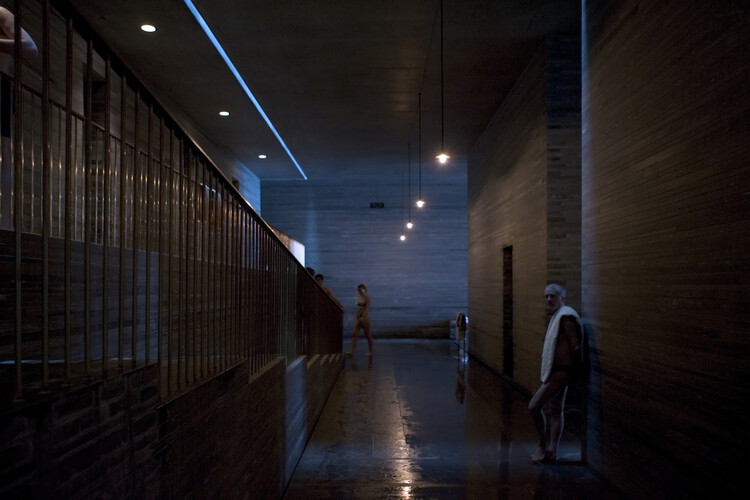Darkish issues: A Name for Much less Gentle
Dark matters: A Call for Less Light

With buildings glazed on all sides and very brightly as well as monotonously lit rooms, it’s no surprise that we long for indoor and outdoor retreats that are less bright. Places with shade from glaring sun, dimmed rooms and exciting contrasts act on the eyes like a welcome oasis. High energy consumption and globally increasing light pollution show how acute the problem of too much light is and the alarming rate of contribution toward climate change. For a better future, it is imperative to explore ways in which we can design and focus on using darkness.

Breaking the monotony of white glow
Nature gives us a fascinating light-dark variety with the daily rhythm of day and night. However, we experience many interiors and especially workplaces quite differently. Bright and constant lighting for hours on end results in monotony. Junichiro Tanizakis’ book “In Praise of Shadow” offers an attractive solution: Japan has developed a multi-layered aesthetics to filter harsh daylight and to understand shadow as an important quality.
In Europe, the artist Rembrandt in his paintings and film noir in cinemas, illustrate how darkness can be used to create an exciting atmosphere. In architecture, the dark rooms of Brutalism introduce a radical critique of white modernism and luminous glass architecture. Sometimes these buildings do not tolerate any hideaways with cool shadows. The desire for darkness finally culminates in Asif Khan`s Pavilion in South Korea. His Vantablack facade color absorbs 99% of light creating the illusion of a void. This layer of color can magically hide walls, furniture and ducts.
Find beauty not only in the thing itself but in the pattern of the shadows, the light and dark which that thing provides. – Tanizaki Jun’ichirō

The emotional balancing act between fear and magic
Dark spaces evoke a combination of unpleasant and pleasant feelings. On the one hand, there is the uncertainty of not being able to see the surroundings and potential lurking dangers. According to an Australian study, many women feel unsafe walking alone through the city at night, concerned that they may be attacked. Yet, it was found that bright and over-lit spaces do not necessarily represent a solution to this problem. The study explained that bright and glaring spaces, do not increase women’s sense of urban safety or attribute to the impression of lower crime. In fact, it was shown that a greater sense of security for women derives from a differentiated approach: The space should be designed holistically with adequate brightness levels, avoiding glare, and harsh transitions into darkness beyond the walkway should be eliminated. Another problem with darkness arises especially in regions with long winter phases. The lack of sunlight has depressive effects on some people leading to seasonal affective disorder – or SAD for short.

On the other hand, there is a certain mystery as sparkling and other bright objects loom fascinatingly out of the darkness. Twilight is often accompanied by the impression of peaceful silence and relaxation before the sleep phase sets in. As surroundings disappear into darkness self-awareness and slowness seem to increase. However, a special fascination and liveliness emanates from places that play with the contrast of much darkness interspersed by a few points of subtle light. For example, a dimmed room with candlelight on the table evokes romance and intimacy in contrast to dull monotonous overhead lighting in canteens during lunch breaks. A sense of magic and concentration can also set in when, out of the darkness, an invisible light source casts a narrow beam of light on a person or object. Theaters play with this secret when the follow spot focuses on the protagonist. At home we can benefit from an intimate island for contemplation when the soft glow for our reading chair rests in a dimmed environment.

Our unconscious adaptation to dark spaces
The human eye is a remarkably flexible and very complex sense organ. Eyes help us to orientate ourselves when intense sunlight with 100,000 Lux or moonlight with less than 1 Lux falls on the ground. This is possible because we have two receptors in our eyes: cones for day vision and rods for night vision. Below about 1 Lux, our rods become active. At this point, colors disappear and we can see faint objects. While the change from dark to light occurs relatively quickly, our eyes need considerably longer to adapt to dark rooms. Therefore, in museums it is best to sequence rooms so that the eye can adapt from bright daylight to dimmed rooms displaying light-sensitive art. Even a small bright light source for barely a moment can completely reverse adapting to the dark in the same way as happens when quickly glancing at the cell phone display whilst stargazing. Therefore, especially in outdoor areas, we need lighting concepts that avoid stark contrasts, and allow good orientation of paths and surroundings by using soft light beams to create gradual transitions.
In the plea for less light, it should of course not be forgotten that vision continuously declines in elderly people and the impression of environmental brightness is thus correspondingly lower. This aspect should be taken into account in lighting design. However, in general the ability for our eyes to adapt allows us to work with less light thereby saving electrical power.

Save energy with less lighting: Your path to more sustainability
Every year, Earth Hour reminds us of the importance of reducing energy consumption and slowing down climate change by symbolically switching off electric lighting for one hour. There is immense potential for energy saving in outdoor lighting. Instead of a constant lighting level, we could dim light when street and pathway lighting is not or hardly required during low usage.
In interiors, brightness and perception is still often understood conventionally. General office task lighting provides a constant and high brightness level of 500 Lux or more at desk level all day ensuring that even the smallest print can be read. Concurrently, for many people, everyday life includes self-luminous screens where brightness and contrast can be individually and conveniently adjusted and small print enlarged simply by zooming in to the document or screen. In this way the screen allows us to think more flexible of the conventional task lighting to save energy.
Accomplish your energy-conscious lighting design also by dividing your space into different zones. Differentiate between bright working areas and secondary areas with lower brightness. In addition, lowering the horizontal brightness on desks can be achieved with luminous monitors without significantly impacting workflow. Another important aspect is to reduce power with lighting control using automatic sensors that individually adjust for each workstation. This means that an elderly employee with lower visual performance is able to adjust the brightness locally in a larger office space without consuming more electricity overall. Offer a low lighting level as a standard scene setting that can be increased as needed.

Recovery retreats from dark dining to Dark Sky Parks
For a radical experience of darkness, dark dining is indispensable whilst providing an exciting interior culinary discovery tour. When our dominant sense of vision completely disappears, our remaining senses like smell, touch and hearing are enhanced and lead us on a sensory journey that can last from the first aperitif to the last dinner course.
Less categorical but also a sensual as well as aesthetic experience are thermal baths that also reduce light to lead to tranquility. Peter Zumthor’s spa in Vals, with its monolithic volumes of natural stone, shows what it feels like to relax inside a mountain. Minimalist gaps for daylight and sparse lighting create mystical interiors to relax as a balance and counterpoint to hectic urban life.

Even the night has become far too bright due to the ever-increasing light pollution. Dark sky tourism has surged as a result and countless city dwellers leave their hectic routines behind to escape to remote outdoor areas to admire night sky constellations and the Milky Way like at the Rhön Dark Sky Reserve. For your own personalized star tour, Visit Dark Sky has developed a comprehensive audio guide that provides both a cultural approach to star constellations and explains the process of our vision at night. Include darkness at home by taking small steps like dimming your lights, enjoying a candlelit dinner, reading Nick Dunn’s and Tim Edensor’s book “Thinking Darkness” or turning off garden lighting for a better night sky view.

Light matters, a column on light and space, is written by Dr. Thomas Schielke. Based in Germany, he is fascinated by architectural lighting and works as an editor for the lighting company ERCO. He has published numerous articles and co-authored the books “Light Perspectives” and “SuperLux”. For more information check www.erco.com, www.arclighting.de or follow him @arcspaces.





